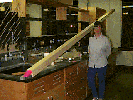 Experiment
Group Home Page
Experiment
Group Home Page

Camera Stand
Steel Ball Bearing
Butcher paper
Carbon Paper
Tape Measure
Boxes
2. Find the angle of the plane.
3. Set up the paper on which the ball will fall.
4. Measure the distances that the ball would roll along the plane and the height the ball would fall after leaving the inclined plane.
5. Roll the ball five times from each distance, using the carbon paper to mark the impact location.
6. For trial two, we used a different angle, and otherwise did everything else the same.
7. For the parabola tracing, we collected boxes and stacked them up. We let the ball roll five times for each height, marking the distances on the same sheet of paper.
8. We measured the distances on the papers and analyzed the data.
 Experiment
Group Home Page
Experiment
Group Home Page
Last Revised April 17, 1995.
Martha Turner, Sharmaine Jennings
mat@rice.edu
vanese@rice.edu